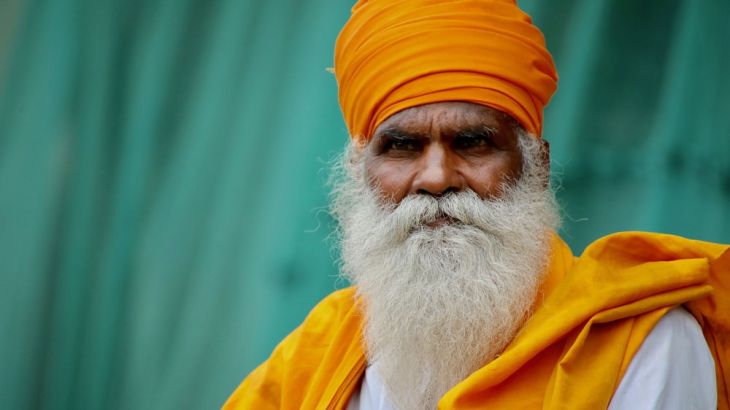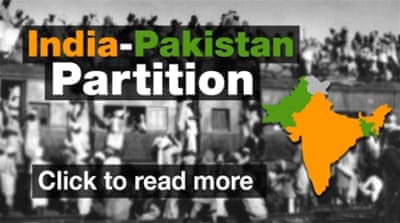Remembering partition: ‘It was like a slaughterhouse’
Seventy years after the partition of India and Pakistan, survivors from both sides recount stories of horror.

“When you see your own mother drenched in blood and stomach opened, intestines coming up, how would you feel?”
Salahuddin Khalid was a young boy living in New Delhi when life as he knew it erupted in a cataclysm of violence and bloodshed.
Keep reading
list of 4 itemsWhat’s Article 370? What to know about India top court verdict on Kashmir
Indians slam ‘unapologetic Islamophobia’ aimed at Pakistan’s cricket team
In cricket-crazy Kashmir, the India-Pakistan World Cup clash tests emotions
It was 1947, and the border between the new nations of India and Pakistan had just been created.
Salahuddin and his family found themselves on the Indian side of the border.
They were Muslims in a land dominated by Hindus and Sikhs.
“I heard a shriek. I turned and I saw a Sikh with a sword in hand and my sister was running,” he recalls.
“First, they entered the room of my mother, killed her, then they ran towards us.”
Salahuddin fled in fear. When he returned, his mother lay mutilated.
“It was just like … a slaughterhouse,” he says.
![It has been 70 years since partition - the moment the subcontinent was divided by Britain, creating India and Pakistan. The number of survivors who remember that moment, and the violence that left more than a million people dead, are fast dwindling, leaving many worried that this part of history may soon be forgotten [Steve Chao/Al Jazeera]](/wp-content/uploads/2017/08/a7efa631c23a4595b16b89338b2f588c_18.jpeg)
Back then, Salahuddin knew little of the political events that foreshadowed the deaths of his mother and at least a million more people across the Indian subcontinent.
But it was people like him who endured the deadly aftermath of Britain’s historic decision to relinquish its Indian empire and carve it into two new nations along religious lines.
Now, 70 years later, memories of the horrors that unfolded as Muslims, Hindus and Sikhs turned on each other, remain raw in the minds of those who survived.
|
|
“When I remember all those things, I feel so much pain and my heart shrinks,” says Salahuddin.
The creation of India and Pakistan prompted the biggest mass migration in human history, as Muslims who were scattered across India and Hindus and Sikhs who were in Pakistan desperately tried to make it to the other side of the border.
As people fled their homes, a wave of violence was unleashed with neighbours turning on each other.
“People who a year before would’ve attended each other’s wedding parties … are murdering each other, raping each other’s daughters, roasting each other’s babies on spits,” says historian William Dalrymple.
He describes how train stations in cities like Lahore, in the new nation of Pakistan, morphed into scenes of mass death.
“The platforms are literally awash with blood because a load of Hindus waiting on the platform to travel to India have been massacred, and another platform was covered with blood because a train had just arrived from India full of dead Muslims. Total chaos,” says Dalyrymple.
READ MORE: One man remembers the ‘poison’ that took over during partition
Amolak Swani was a 17-year-old Hindu girl living with her parents in Peshawar, Pakistan, when she heard that a Muslim mob was approaching their home.
Her father told her and her mother that the attackers were setting homes on fire and taking women away.
“He was very frightened and he quickly gave my mother a bottle of petrol and some matches and told her … ‘If we don’t survive downstairs, then don’t give up your honour. Pour the petrol on yourself and our daughter and don’t let yourself be taken into the hands of those people’,” she says.
The attackers eventually passed by their house, and Amolak and her family fled to the Indian city of Amritsar.
 |
| Follow Al Jazeera’s coverage of the 70 years of India-Pakistan partition |
But other women didn’t escape.
Sardar Joginder Singh Kholi, a Sikh teenager at the time of partition, recalls a woman named Veerawaali who lived in his village in Pakistan’s Punjab province.
“She was a very beautiful woman. But during the unrest … Muslims were chasing after her,” he says.
“There was a Sikh temple in our village, so she ran inside the temple to take refuge. She paid her respects to the holy book … doused her body in kerosene and set herself on fire.”
She wasn’t the only one of Sardar’s neighbours who died. He recalls what happened to the men of the village when the attackers arrived.
“Out of the 25 men who were there, they murdered 18,” says Sardar, now 86.
“I cried a lot. Now I think of it, I feel that something happened to all of us. It’s as if humanity had died. Everybody became a devil.”
READ MORE: Partition riots were ‘a grave attack on all of humanity’
![A woman worships at the Monkey Temple in New Delhi, India. In 1947, when independent India and Pakistan were created, Hindu, Sikh and Muslim mobs attacked each on the streets of the capital and other places throughout the Indian subcontinent [Steve Chao/Al Jazeera]](/wp-content/uploads/2017/08/4906ab4da40d4204ab17a136f0012712_18.jpeg)
The atrocities have spawned decades of hostility between Pakistan and India, but on both sides of the border, there are efforts to chip away at the hatred that remains.
In the Indian city of Amritsar, a new museum is helping keep alive the memories of that era.
With survivors ageing, curator Mallika Ahluwalia says it was crucial that the Partition Museum be established while there is still a living connection to the personal stories of that era.
|
|
“It’s about the impact on each person who went through it. And what it would have felt like for them to leave behind their homes, to leave behind their friends, to leave behind the lives they’ve known and to move to a new land,” Ahluwalia says.
“It was less migration of people or partition of assets – it was this collective migration of sorrow.”
But Mallika wants the museum to be more than just a place of sad reflection. She wants to commemorate the acts of kindness that crossed religious divides and saw Muslims, Sikhs and Hindus protect each other from violence.
“I think it’s really important that we highlight those stories of humanity, that we highlight those stories of friend helping friend, neighbour helping neighbour … stranger helping stranger,” she says. “Those narratives shouldn’t get lost.”
On the other side of the border, the Citizens Archive of Pakistan has recorded the stories of more than 2,200 survivors in the last decade.
Aaliyah Tayyebi, a senior project manager for the non-profit organisation’s oral history project, says hearing the perspectives of ordinary citizens who lived through partition is vital.
“I feel if narratives of people who have suffered from both sides, whether that be a Hindu, a Muslim or a Sikh, come to the forefront and people get to hear it, then it will make them realise the horrors of war,” she says. “It would make them understand that killing one another does not solve anything.”
|
|
Aaliyah believes today’s generation needs to learn from Pakistan’s history.
“We can use it as a tool to make us better people or we can just run from it and never look back and pretend it never happened, but then we will just be foolish,” she says.
Creating a better understanding of what went on when the country was created would help foster better relations with India, Aaliyah believes.
“We are neighbours. We need to understand that for the greater good of both countries, it would benefit us to respect one another, tolerate one another, understand from our past and come to a better future.”
But some survivors, like Salahuddin Khalid, say there’s no way they can forgive the brutality they endured.
“How can I?” he asks. “You can give me tonnes of gold, tonnes of money, can you give me my mother?”
![Mallika Ahluwalia is a co-founder of the first museum to commemorate the partition of India and Pakistan in 1947. The museum, in Amritsar, India, recounts not only the tragedy of partition, where more than a million people died, but also the positive stories where Sikhs, Hindus and Muslims helped each other [Steve Chao/Al Jazeera]](/wp-content/uploads/2017/08/337eaafb25734a37b1fa595770015781_18.jpeg)